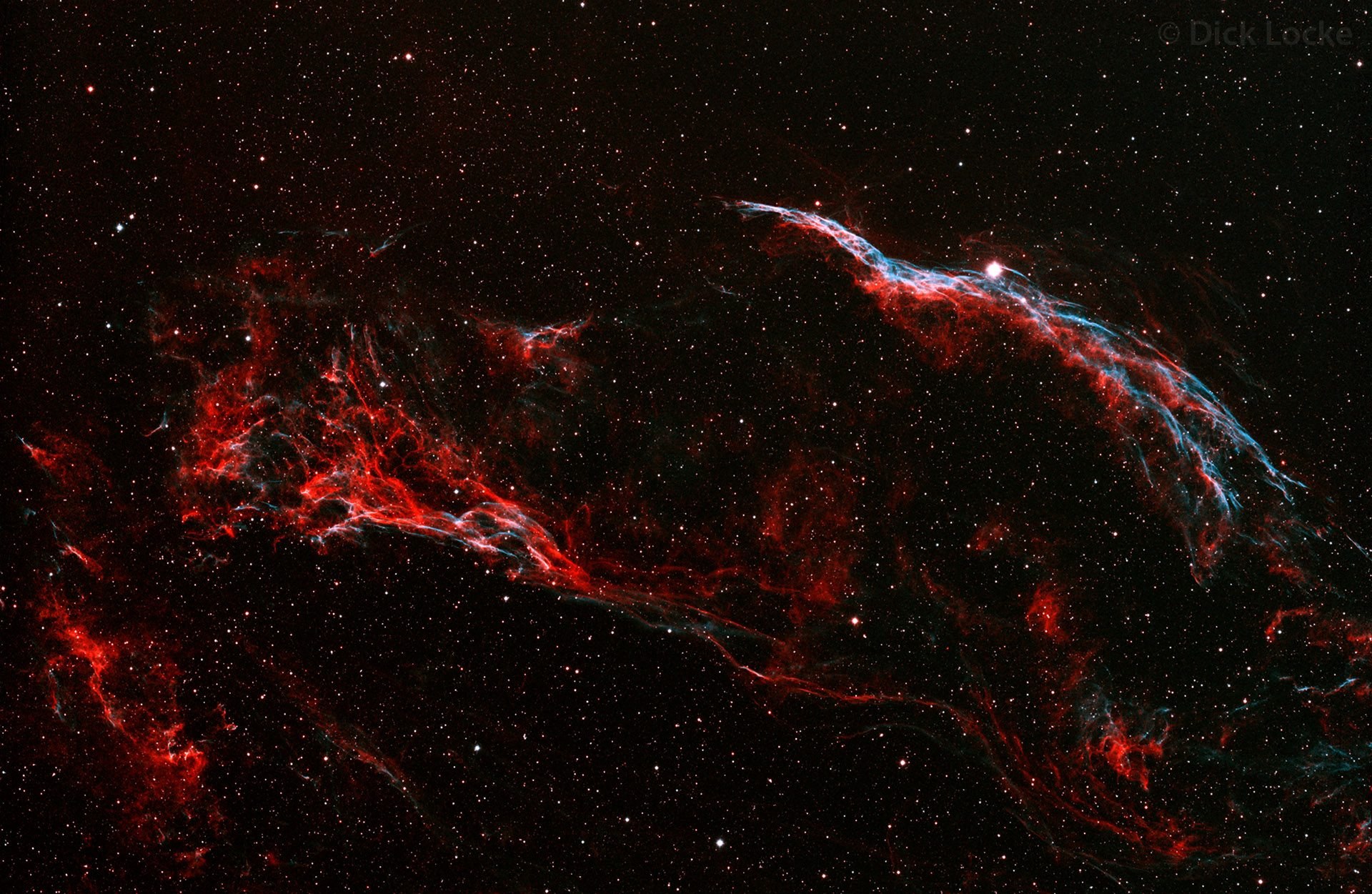
Western Veil 2020
Cygnus Area Image Index (Pictures of Objects in the Cygnus Area)

Object Information: Western Veil Nebula and Pickering's Triangle Narrowband Picture – 12 hours total exposure
NGC6960 in Cygnus, the western part of the Veil Nebula. The veil was formed from
a supernova over 5,000 years ago, and is about 1500 light-years away. Also known
as: Caldwell 34, Witch's Broom, Cirrus Nebula, Filamentary Nebula, Lace-work
Nebula, Veil Nebula. The bright star, 52 Cygni, makes this part of the veil easy
to locate. The interesting area in the left is known as Pickering's Triangle. I
specifically framed this to capture that bit.
NGC6960 in Cygnus, the western part of the Veil Nebula. The veil was formed from
a supernova over 5,000 years ago, and is about 1500 light-years away. Also known
as: Caldwell 34, Witch's Broom, Cirrus Nebula, Filamentary Nebula, Lace-work
Nebula, Veil Nebula. The bright star, 52 Cygni, makes this part of the veil easy
to locate. The interesting area in the lower left is known as Pickering's
Triangle. I specifically framed this to capture that bit.
Image Capture Details: 12 hours total imaging time (58 * 5 min Ha plus 86 * 5
min O3 frames) collected over the last several weeks with MaximDL in the back
yard. SBIG ST-8300 CCD camera with the FW8-8300 filter wheel, Astrodon
narrowband 36mm filters, the Takahashi FSQ-85 telescope at native 450mm, AP
900GTO mount. Guiding via PHD, an ASI462MC camera, and a Sky-Watcher EVOGUIDE
50ED guide scope mounted to the finder bracket. (This replaces my old, perhaps
antique, STV, ST80, and heavy side-saddle guiding setup previously used).
Image Processing Details: Lights were calibrated with 58 darks, 16 each flats,
32 each flat darks, and 128 bias frames and each channel was stacked in DSS
producing a 32 bit .tif file. I then processed the file in Photoshop, converting
to 16 bit RGB, and combined the images in Registax padding them to equal size. I
then did the channel manipulation and final processing steps in Photoshop, with
the most elaborate steps involving star selection & shrinking using old
Astronomy Tools 1.6 actions. I think did a rotate, crop, and resize to 1920
pixels wide.
When I decide I’m done capturing frames, and have a day or two to spare, I will
give this a whirl in PixInsight. But I went with what I know for now.
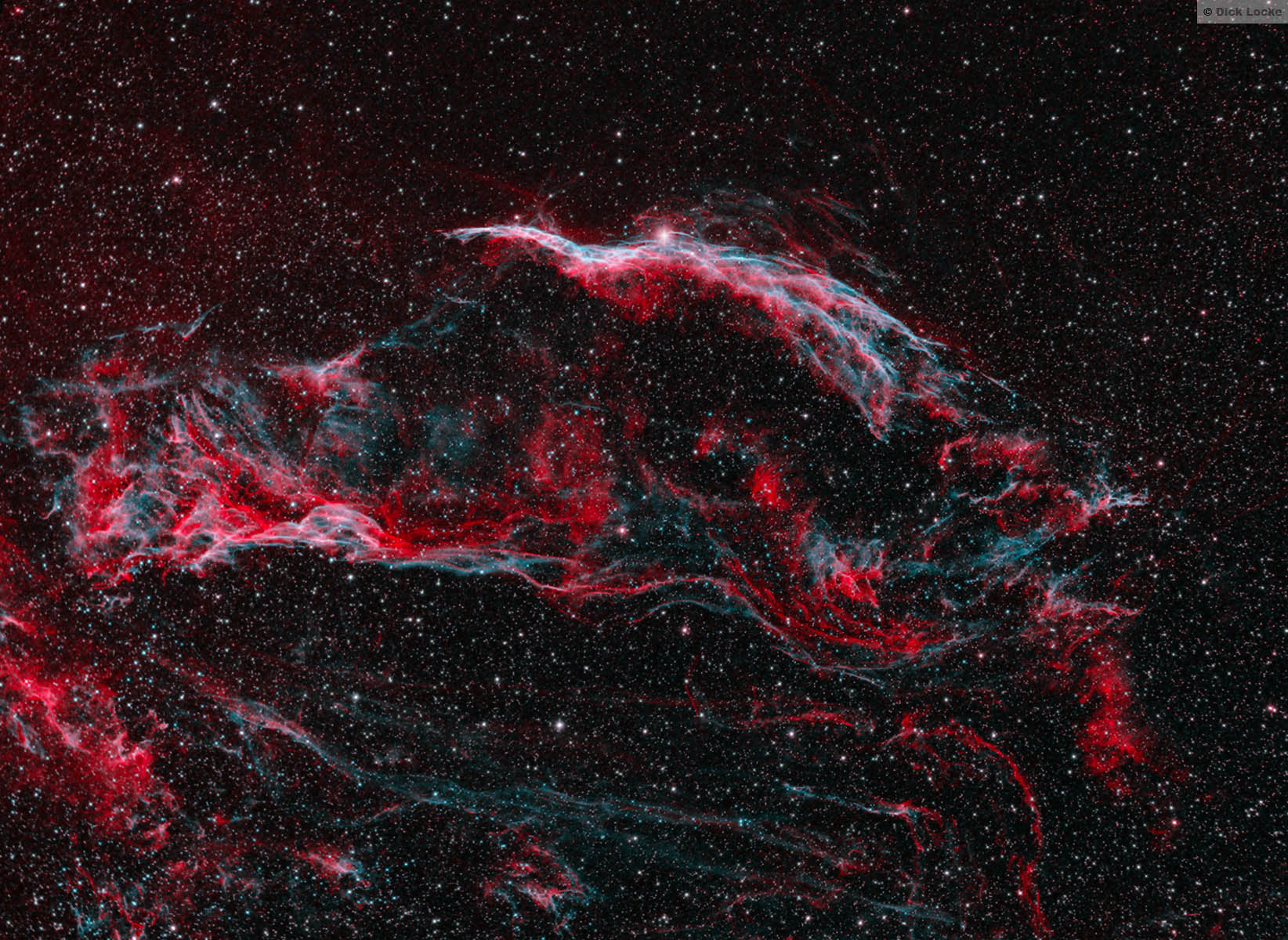
NGC6960 in Cygnus, the western part of the Veil Nebula. The veil was formed from a supernova over 5,000 years ago, and is about 1500 light-years away. Also known as: Caldwell 34, Witch's Broom, Cirrus Nebula, Filamentary Nebula, Lace-work Nebula, Veil Nebula. The bright star, 52 Cygni, makes this part of the veil easy to locate. The interesting area in the lower left is known as Pickering's Triangle. This image is reprocessed from the same source the older narrowband image.
Wikipedia has good reference information about the Veil Nebula. It says: The brighter segments of the nebula have the New General Catalog designations NGC 6960, 6974, 6979, 6992, and 6995. The easiest segment to find is 6960, which runs behind the naked eye star 52 Cygni. NGC 6992/5 are also relatively easy objects on the eastern side of the loop. NGC 6974 and NGC 6979 are visible as knots in an area of nebulosity along the northern rim. Pickering's Triangle is much fainter, and has no NGC number (though 6979 is occasionally used to refer to it)
Image Details: 30*5 H-alpha frames blended into 35*5 minute O3 frames in Blue/Green, about 5.5 hours total exposure. The O3 frames were binned 2x2 and I would not do that again with this object (I'd shoot 1x1) as it caused a lot of star quality issues. Equipment: SBIG ST-8300 CCD camera with the FW8-8300 filter wheel, Astrodon narrowband 36mm filters, the Takahashi FSQ-85 telescope with reducer, AP 900GTO mount. Other narrowband pictures with this combination, and more info, are at this link. Other astronomy pictures from the Fall 2011 trip are here.
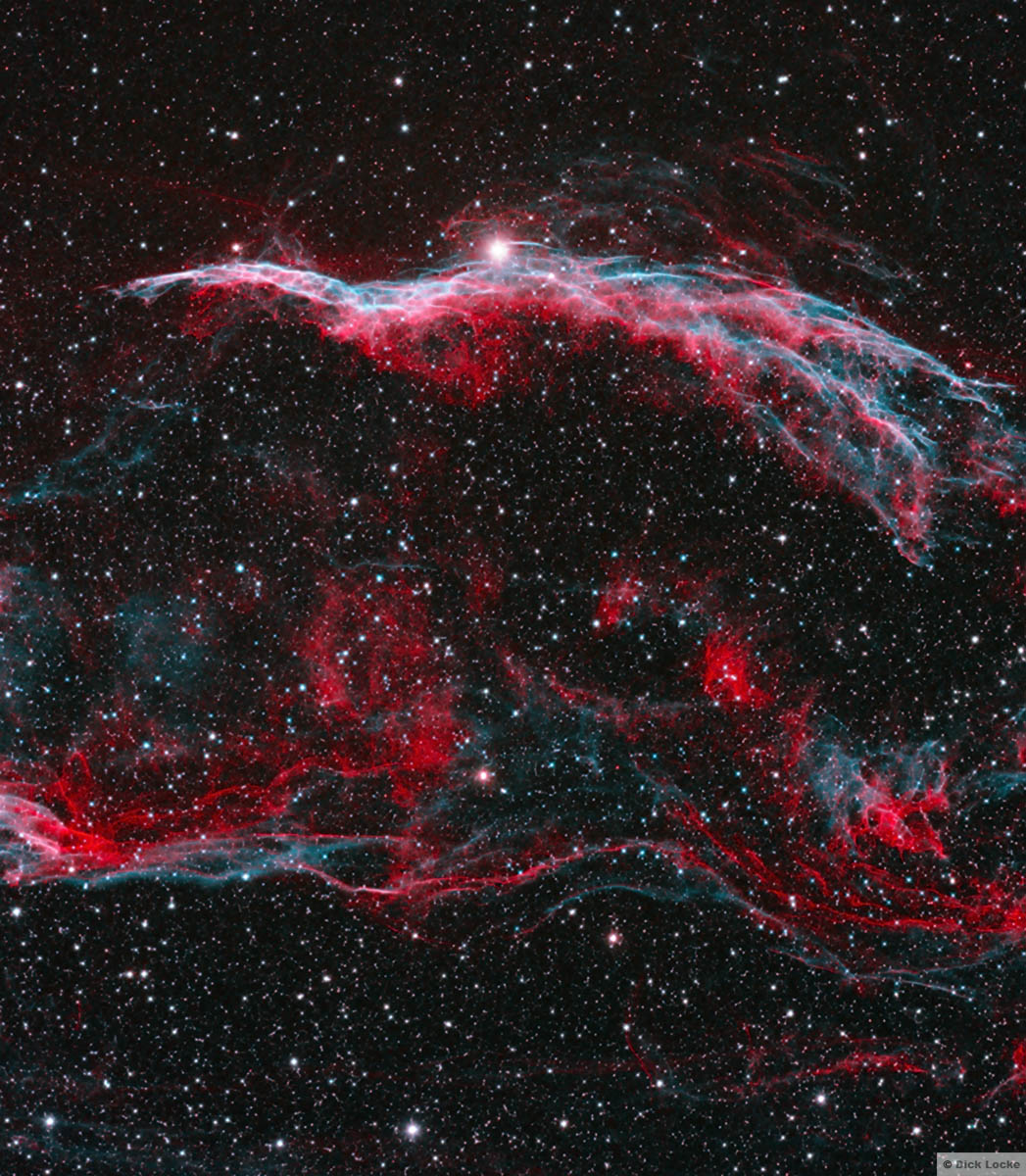
The image above consists of the 65 * 5 minute frames of narrowband data,
combined with 56 * 5 minute ~ 5.6 hours of QHY8 camera data through the TOA 130
& Reducer. The QHY8 is a "color" camera, and I blended that at 25% of the
overall image.
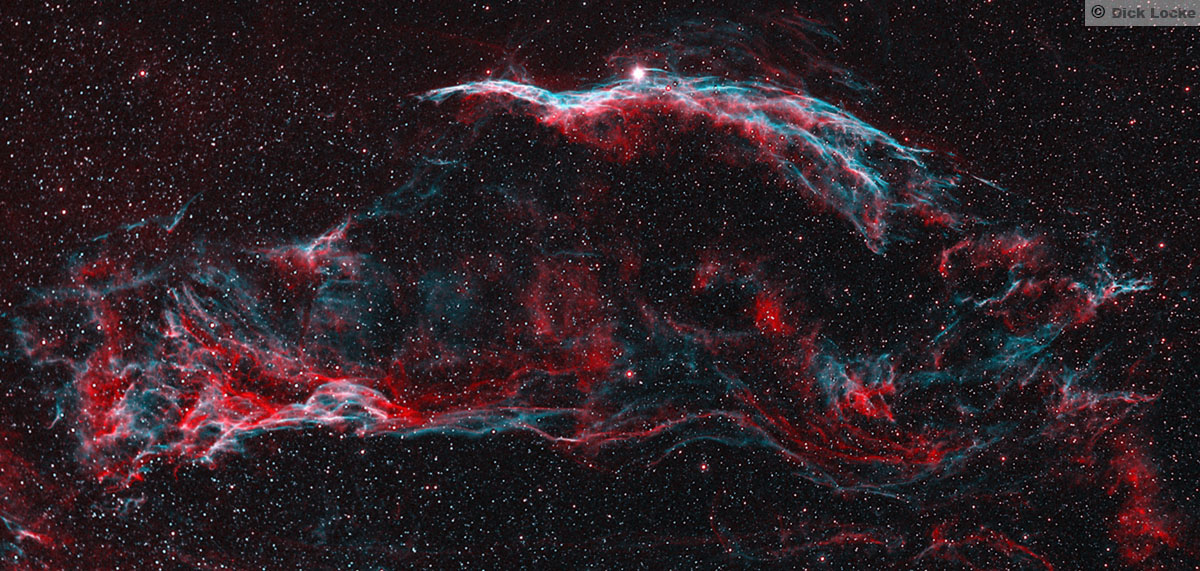
Details same as top image, but processed in more of a "quick and dirty" mode.
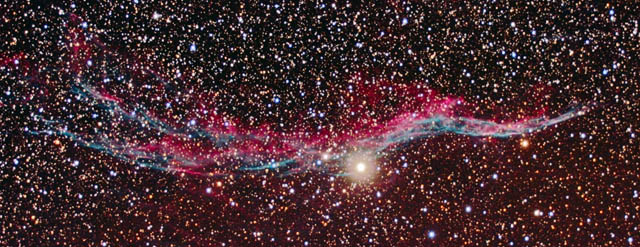
This area of the sky has so many stars that they tend to overwhelm the delicate nebula when normal processing techniques are used. I am going to make another pass at this and try to suppress the stars. The dim red color below the nebula does appear to be "real" after reviewing other deep exposures of this area and this has been independently corroborated.
Image: November 2006 with Canon 20Da; combination of approximately 30 - 4 minute exposures = 120 minutes (2 hours) total exposure. My current image processing workflow is here.
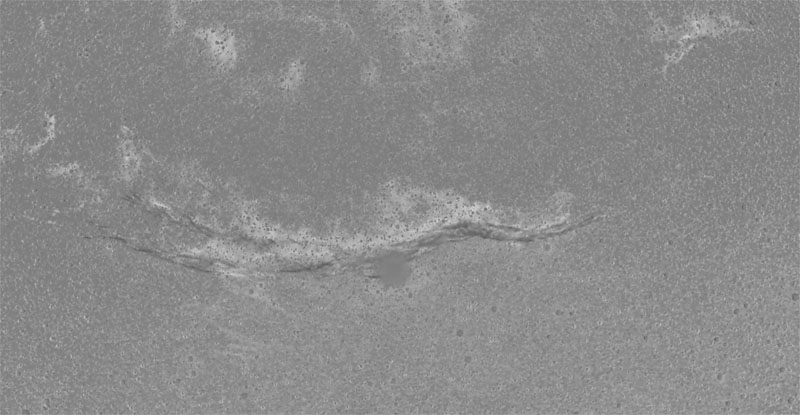
What's this? This is the LAB "a" channel of (uncropped) the Veil Image!
November 2006 Equipment: Canon EOS 20Da (unmodified), Takahashi TOA 130 (a 5" APO refractor) with reducer, guided with SBIG STV, Losmandy G-11 mount.

Copyright © by Dick Locke. All Rights Reserved.
Contact and Image Use Information